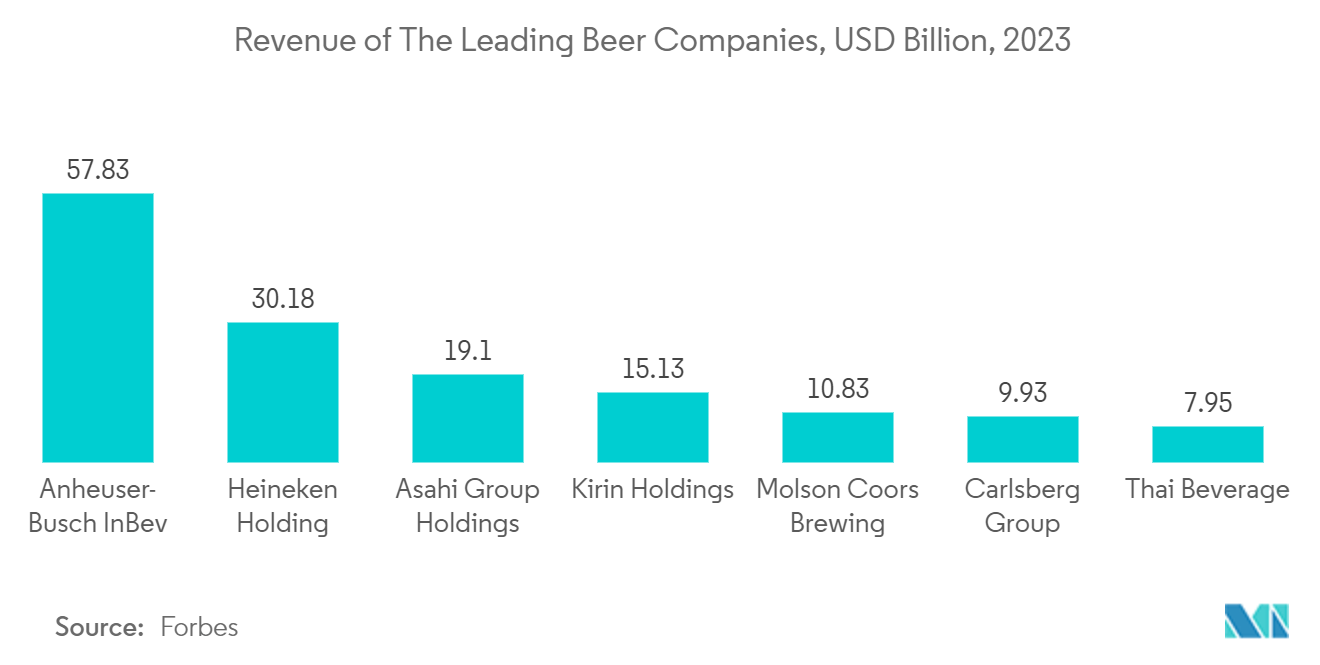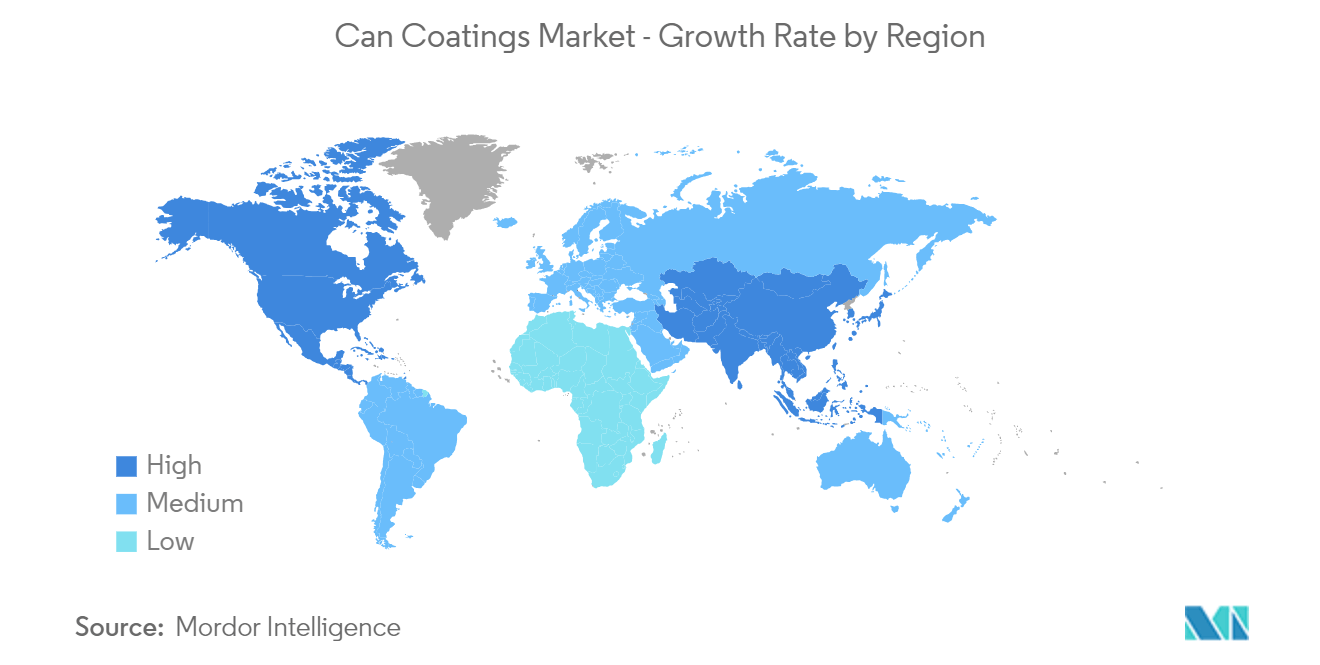Market Trends of Can Coatings Industry
Beverage Cans to Dominate the market
- Epoxy coatings on cans are used a lot by companies that make beverage cans for a wide range of purposes. However, in recent years, manufacturers have started substituting epoxy-based coatings with other replacements owing to their toxicological presence and regulatory policies put forth by various governing agencies.
- The demand for canned food and beverages has been increasing over time. The growing preference for canned fruit juice and beer among people in recent times has been boosting the demand for cans and other metal caps, which may further drive the applications of epoxy-based packaging coatings in the coming years.
- Acrylic and polyester coatings are currently being used as first-generation substitutes to epoxy coatings, and more recently, polyolefin and non-BPA epoxy coatings were developed.
- The beverage can category has been experiencing substantial product improvement because of the strong presence of major players like Ball Corp., which is in the most advanced economies worldwide. To respond to growing demand, companies are expanding in a significant way.
- Lion Beverage has signed an agreement granting it the possibility to expand its production capacity. Lion announced the construction of a new facility at Pittston, United States, for USD 25 million on April 22, 2022. Two new cannery lines are planned for the new facility, producing approximately 1,600 cans per minute.
- In addition, the new plant is expected to produce 40 million cans a year, including beer and noncarbonated beverages. Hence, this may promote market growth. In addition, the increased use of beverage cans is mainly due to the superior physical characteristics of metals, including high malleability, ease of labeling, and printing on metal surfaces, among others.
- In 2021, China drank about 274.8 billion liters of packaged drinks. By 2024, they were expected to drink 302.4 billion liters.The total global consumption will amount to approximately 1.35 trillion liters in 2021.
- To cater to the shortage of supply for aluminum cans, many companies are working on expanding their production capabilities. For instance, in September 2021, Ball Corporation announced plans to build a new US aluminum beverage packaging plant in Nevada, United States. This multi-line plant began production in late 2022. The company plans to invest around USD 290 million in this facility over the next few years. Even with the adjustments and increased manufacturing capacity, Ball Corporation anticipated that the demand would continue to outstrip supply well into 2023.
- The expansion of modern convenience stores and supermarkets across the country geared up, adding growth to the packed beverage sales and thus benefiting the market studied. For instance, in July 2022, WinCommerce, a retail giant, plans to open hundreds of new supermarkets and convenience stores in Vietnam by the end of the year to cater to the increased demand for convenience food products and accelerate the expansion of its market share in the country.
- Therefore, the growing consumption of packed beverages is expected to fuel the demand for can coatings globally through the years to come.

Asia-Pacific Region to Dominate the Market
- China has remained the world’s largest producer and exporter of canned food, with its output accounting for nearly 25 percent of the world’s total, and is being exported to nearly 200 countries and regions.
- However, in recent years, the demand for aluminum cans has been increasing due to the advantages of the product, including long shelf life, 100% recyclability, the ability to stay cold for longer periods, portability, and ease of transportation.
- Companies such as Zhangzhou Tan Co., Ltd. (a food company) began exporting canned food in 2003 and has exported to around 145 countries. The company’s export volume of canned food surged more than 20 percent from 2019 to 2022.
- According to Invest India and the Ministry of Food Processing Industries, India’s food processing sector is one of the largest in the world, and its output is expected to reach USD 535 billion by 2025-26.
- Under Pradhan Mantri Kisan Sampada Yojana (PMKSY), 41 Mega Food Parks, 376 Cold Chain projects, 79 Agro-Processing Clusters, 489 proposals under the Creation/Expansion of Food Processing and Preservation Capacities (CEFPPC), 61 Creation of Backward and Forward Linkages Projects, 52 Operation Green projects, 183 Food Testing Laboratories projects have been approved across the country.
- There is a significant degree of scope and improvement in terms of the canned food and beverage industry. A lot of new products are expected to be launched in cans, such as canned meat products, tuna in olive oil, water, and brine variants. For instance, in March 2023, Reliance Consumer Products Limited (RCPL), the FMCG arm and a wholly-owned subsidiary of Reliance Retail Ventures Limited (RRVL), announced the launch of the beverage brand Campa which will also be available in cans.
- The ASEAN region has one of the major food industries across the world. The growing demand for food in these countries is a major driving factor for the packaging sector. Thus, this increases the demand in the can coatings market in the region.
- According to Statistics Indonesia, in 2022, the gross domestic product (GDP) from manufacturers of food products and beverages in Indonesia was about IDR 1.2 quadrillion. The GDP from manufacturers of food products and beverages in Indonesia has gradually increased since 2014, which amounted to IDR 562.02 trillion.
- In 2022, the foreign direct investment in the food industry in Indonesia amounted to approximately USD 2.4 billion. This was the highest foreign direct investment in the industry since 2017.
- In Vietnam, according to the General Statistics Office of Vietnam and the Ministry of Industry and Trade (Vietnam), in 2022, food product manufacturing grew by 108.8 percent in Vietnam. In the same year, the production of beverages grew by 132.3 percent. There are over 8,500 registered companies in the food processing sector, and the total food ingredients demand is more than 120 million tons per year. Seafood, milk powder, fresh milk, and animal feed saw the fastest growth in 2022.
- The consumer goods industry in the ASEAN region has been witnessing significant growth, owing to factors like growing urbanization, increasing retail outlets, and growing penetration of e-commerce.
- This growth in the consumption of consumer goods is expected to provide growth to the can coatings industry in Asia-Pacific region.

